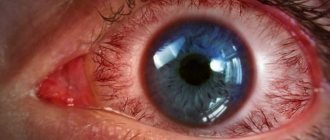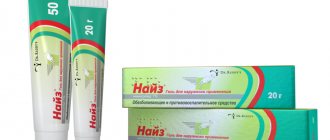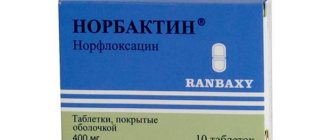Release form and composition
Tetracycline is available in the following forms:
- film-coated tablets, 100 mg: biconvex, round, red in color, a yellow core is visible on the cross section (10 pieces in a contour strip pack, in a cardboard pack of 1, 2 or 4 packs; 20 pieces in polymer jars, in cardboard pack 1 can; 40 pieces in dark glass jars, 1 can in a cardboard pack);
- ointment for external use 3%: yellow (10 g or 15 g in aluminum tubes, 1 tube in a cardboard pack; 15 g in polymer tubes, 1 tube in a cardboard pack);
- eye ointment 1%: yellowish or yellowish-brown color (2, 3, 5 or 10 g in aluminum tubes, 1 tube in a cardboard box).
Composition of 1 tablet:
- active ingredient: tetracycline hydrochloride – 100 mg;
- auxiliary components: microcrystalline cellulose, povidone, calcium stearate, potato starch, talc, sodium starch glycolate;
- film shell: polysorbate-80, hypromellose, titanium dioxide, silicone emulsion KE 10-16, tropeolin O dye, azorubine dye.
Composition of 1 g ointment for external use:
- active ingredient: tetracycline hydrochloride – 30 mg;
- auxiliary components: solid petroleum paraffin, sodium disulfite, anhydrous lanolin, ceresin, petroleum jelly.
Composition of 1 g eye ointment:
- active ingredient: tetracycline hydrochloride – 10 mg;
- auxiliary components: anhydrous lanolin, petroleum jelly.
Indications for use
Film-coated tablets
- bronchitis, pneumonia, tonsillitis, pleural empyema, endocarditis;
- pyelonephritis, cholecystitis, intestinal infections;
- bacterial infections of the genitourinary organs (prostatitis, endometritis, uncomplicated gonorrhea, syphilis, lymphogranuloma venereum, inguinal granuloma, chancroid);
- purulent soft tissue infections;
- rickettsiosis, brucellosis, anthrax, intestinal amebiasis, cholera, bartonellosis, actinomycosis, plague, listeriosis, typhus, ornithosis, relapsing fever, yaws, tularemia;
- osteomyelitis;
- acne;
- conjunctivitis, trachoma, blepharitis;
- prevention of postoperative infections.
Ointment for external use
- acne;
- furunculosis;
- folliculitis;
- infected eczema;
- purulent infections of soft tissues.
Eye ointment
- barley;
- blepharitis;
- keratitis;
- blepharoconjunctivitis;
- keratoconjunctivitis;
- trachoma.
Indications
The drug is prescribed locally for burns, mastitis, phlegmon, the development of infected eczema, and acne.
Oral forms of the drug are included in therapeutic regimens to combat pneumonia, bronchitis, tracheitis, endocarditis and whooping cough.
The drug effectively prevents the development of diseases such as cholecystitis, pyelonephritis, osteomyelitis, pharyngitis, tonsillitis, otitis media. In addition, Tetracycline hydrochloride is widely used in the treatment of:
- brucellosis;
- sexually transmitted diseases (syphilis, gonorrhea);
- inflammation of the prostate gland, uterine mucosa;
- purulent infections localized in soft tissues;
- dental ailments (gingivitis, stomatitis).
The drug is often used to prevent infectious complications in patients who have undergone surgery.
Experts recommend using Tetracycline for diarrhea (if the bacterial etiology of the disease is confirmed).
Injections and infusions are used:
- to relieve symptoms of severe forms of infectious diseases (sepsis, peritonitis);
- if the patient is unable to take the oral form of the medication.
Eye ointment is used in the treatment of trach, keratitis, and blepharitis.
- Tetracyclines - what kind of drugs;
- Tetracycline analogues;
- About antiviral antibiotics.
Contraindications
Film-coated tablets
- leukopenia;
- renal failure;
- fructose intolerance, sucrase/isomaltase deficiency, glucose-galactose malabsorption syndrome;
- pregnancy period;
- breastfeeding period;
- children under 8 years of age;
- increased individual sensitivity to the main or auxiliary components of the drug.
Tablets are prescribed with caution to patients with a history of allergic reactions.
Ointment for external use
- fungal skin infections;
- renal failure;
- pregnancy period;
- breastfeeding period;
- children under 11 years of age;
- increased individual sensitivity to the components of the drug.
Eye ointment
- impaired renal and/or liver function;
- pregnancy period;
- breastfeeding period;
- children under 8 years of age;
- increased individual sensitivity to the components of the drug.
Contraindications for tetracycline hydrochloride
Contraindications are the same as for other tetracycline preparations prescribed orally, as well as the presence of a pronounced reaction at the site of previous administration or the appearance of persistent infiltrates.
Due to their acidic reaction, they should not be administered together with penicillins and other acid-sensitive chemotherapy drugs.
Not prescribed for intestinal infections, such as dysentery, colienteritis and others (except cholera).
Directions for use and dosage
Film-coated tablets
Tetracycline tablets are taken orally with plenty of water or other liquid.
The recommended dose for adult patients is 300–500 mg 4 times a day (every 6 hours) or 500–1000 mg 2 times a day (every 12 hours). The maximum dose is 4000 mg per day. The duration of therapy is from 5 to 10 days.
For children over 8 years of age, the drug is prescribed at 6.25–12.5 mg/kg body weight 4 times a day (every 6 hours) or 12.5–25 mg/kg body weight 2 times a day (every 12 hours). ).
Recommended doses and duration of treatment for adult patients for certain diseases:
- uncomplicated gonorrhea: 1500 mg once, then 500 mg 4 times a day (every 6 hours) for 4 days;
- uncomplicated rectal, endocervical and urethral infections caused by Chlamydia trachomatis: 500 mg 4 times a day for at least one week;
- syphilis: 500 mg 4 times a day for 15 days (for early syphilis) or 30 days (for late syphilis);
- lymphogranuloma venereum, inguinal granuloma: 500 mg 4 times a day for 3–4 weeks;
- brucellosis: 500 mg 4 times a day for 3 weeks with simultaneous intramuscular administration of streptomycin at a dose of 1000 mg 2 times a day during the first week and 1 time a day during the second and third weeks;
- listeriosis: 200–300 mg 4 times a day for 7–10 days;
- chlamydia: 1500–2000 mg per day for 10 days (for fresh forms) and 15–20 days (for chronic and complicated forms);
- actinomycosis: 3000 mg per day in the first 10 days of treatment, then 500 mg 4 times a day for 18 days;
- Lyme disease (early stage only): 1000–1500 mg per day for 10–14 days;
- psittacosis: 500 mg 4 times a day for 7–14 days;
- rickettsiosis: 800–1200 mg per day for 8–10 days;
- tularemia: 1500–2000 mg per day, treatment is continued for another 5–7 days after the temperature normalizes;
- plague: up to 6000 mg per day, after improvement of the condition, the dose is reduced to 2000 mg per day until body temperature normalizes (but not less than 3 days); persons in contact with the patient must undergo a preventive course (300 mg 4 times a day);
- yaws: 500 mg 4 times a day for 14 days;
- acne: 500–2000 mg per day in divided doses; when the condition improves (usually after 3 weeks), it is necessary to gradually reduce the dose to a maintenance dose of 100–1000 mg per day. Adequate remission of acne is achieved with intermittent treatment or use of the drug every other day.
Ointment for external use
Tetracycline in the form of an ointment for external use is applied to the affected areas 1-2 times a day. It is possible to use a gauze bandage, which is changed 1-2 times a day. The duration of therapy varies from several days to 2–3 weeks.
Eye ointment
Tetracycline in the form of an eye ointment is used topically. A strip of ointment 0.5–1 cm long is placed behind the eyelid.
Frequency of use and duration of treatment:
- barley: daily at night, course of treatment until symptoms disappear;
- keratitis and keratoconjunctivitis: 2–3 times a day, course – 5–7 days;
- blepharitis and blepharoconjunctivitis: 3–4 times a day, course – 5–7 days;
- trachoma: every 2–4 hours or more often in the first 1–2 weeks; when the inflammation process subsides, the ointment is used 2-3 times a day for 1-2 months.
Cautions
The drug "Tetracycline" in any form is contraindicated in case of liver failure, mycoses, leukopenia, or intolerance to the components of the drug.
Tetracycline should not be taken by nursing or pregnant women, as well as by children under 8 years of age. The drug should not be consumed simultaneously with dairy products, as this complicates its absorption. During the therapy period, it is recommended to take vitamins B and K. Tetracycline therapy can cause side effects such as abdominal pain, stool disorders, vomiting, headaches, allergic and dermatological reactions. Changes in liver and hematopoietic system parameters are possible. There may also be pain at the injection site.
Side effects
Film-coated tablets
- digestive system: decreased appetite, nausea, vomiting, gastritis, glossitis, hypertrophy of the tongue papillae, pancreatitis, diarrhea, ulceration of the mucous membrane of the duodenum and stomach, enterocolitis, intestinal dysbiosis, hepatotoxic effect, increased activity of liver enzymes, antibiotic-associated diarrhea;
- hematopoietic system: thrombocytopenia, eosinophilia, hemolytic anemia, neutropenia;
- central nervous system: headache, increased intracranial pressure, toxic effects on the central nervous system (instability or dizziness);
- urinary system: hypercreatininemia, azotemia, nephrotoxic effect;
- immunopathological and allergic reactions: skin hyperemia, photosensitivity, maculopapular rash, angioedema, drug-induced systemic lupus erythematosus, anaphylactoid reactions;
- other reactions: hypovitaminosis of B vitamins, discoloration of tooth enamel (in children), candidiasis, stomatitis, hyperbilirubinemia, superinfection.
Ointment for external use
Allergic reactions are possible: mild burning, itching, swelling, skin hyperemia, photosensitivity.
Eye ointment
- swelling and hyperemia of the eyelids;
- blurred vision (goes away on its own);
- hypersensitivity reactions.
Pharmacokinetics of tetracycline hydrochloride
Introduction
When administered intramuscularly, tetracycline hydrochloride quickly forms high concentrations in the blood, and then in tissues and internal organs.
It can also be administered into cavities, subject to strict adherence to the necessary precautions to avoid irritation of the serous membranes (in a solution of novocaine and in a sufficiently diluted state).
It cannot be administered intravenously due to its sharply acidic reaction.
Distribution
It is well absorbed in the rectum , without having a noticeable irritating effect on its mucous membrane.
special instructions
During treatment with Tetracycline, direct exposure to sunlight should be limited, as the drug can cause photosensitivity.
During long-term treatment, it is necessary to periodically monitor the function of the liver, kidneys and hematopoietic organs.
Tetracycline can mask the symptoms of syphilis, so if there is a possibility of a mixed infection, a serological test should be performed monthly for 4 months.
It is not recommended to prescribe the drug to children during the period of tooth development, since hypoplasia and irreversible staining of tooth enamel in a yellow-gray-brown color are possible.
In order to prevent hypovitaminosis during treatment with Tetracycline, you should take brewer's yeast and vitamins B and K.
If there is no improvement within a few days, you should consult a doctor.
During treatment with oral forms of Tetracycline, you should refrain from driving or engaging in other potentially hazardous activities.
Drug interactions
When taken orally, the drug reduces the effectiveness of bactericidal antibiotics that disrupt cell wall synthesis (cephalosporins, penicillins), and also reduces the therapeutic effect of oral contraceptives.
When used simultaneously with indirect anticoagulants, the prothrombin index decreases (a reduction in the dose of anticoagulants is required); with retinol – the risk of increased intracranial pressure increases; with chymotrypsin – the concentration and duration of circulation of tetracycline increases.
Absorption of the drug is reduced when used together with cholestyramine, antacids containing magnesium, calcium and aluminum ions, and iron-containing agents.
No drug interactions have been described with external and local use of Tetracycline.
Action (indications) of tetracycline hydrochloride
Indications for use are the same as for tetracycline hydrochloride tablets or capsules.
It is administered intramuscularly to severely ill patients, when it is necessary to quickly create high concentrations of the drug in the blood or when oral administration is impossible or difficult.
With parenteral administration of tetracycline hydrochloride does not cause significant dysbiosis or candidiasis in the alimentary canal, and dyspeptic complications, due to the lower dosage and the lack of direct irritant effect on the intestinal mucous membranes, are rarely observed.
Intramuscular administration is accompanied by significant pain at the injection site. Therefore, it is administered only with 2% novocaine solution, although this does not completely eliminate pain.










